From the outside, Bert Yarborough’s Truro studio, located in an industrial complex, doesn’t look like much. It is housed in a row of identical rented units, each with a windowless front door. Inside, it’s a different story — 30 feet high and deep enough to accommodate the artist’s entire oeuvre.
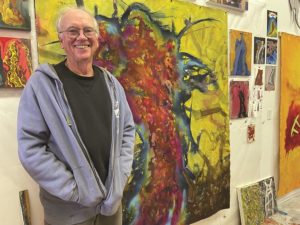
“This is it — everything I’ve ever touched,” says Yarborough, 68. “Everything I’ve ever made that hasn’t been sold, given away, lost, or stolen.” After passing through several other studios, Yarborough — like a snail with its home upon its back— moved there in fall 2017. The move took six months and involved some 30 trips with a 16-foot van. “It was a killer,” he says. “I ain’t going nowhere!”
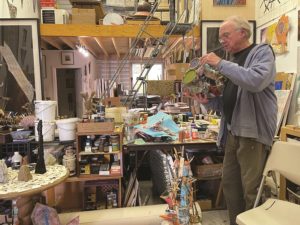
His friends Bob Bailey and Jerome Greene, also artists, built a loft in the back third of the space. It is full of metro-shelving that stores boxes, paintings, and frames. “They came in here one day, eight to five,” says Yarborough. “And boom! It was done.
“I’m a hoarder,” he continues. “That’s why I’m recycling stuff by building sculptures out of it.” He gestures to the amorphous spun-plastic forms that populate his studio. Yarborough says they are inspired by medieval mountainscapes as well as East Asian brush paintings. “They take a long time because I don’t know what I’m doing,” he adds.
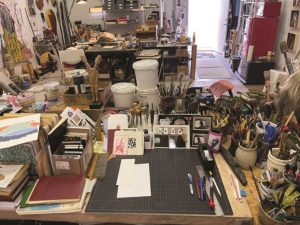
Yarborough got a B.A. in architecture from Clemson University in South Carolina before receiving an M.F.A. in photography from the University of Iowa. He first came to Provincetown as a fellow at the Fine Arts Work Center in 1976 and later became its visual program committee chair. He recently retired from a long teaching career at Colby-Sawyer College in New London, N.H.
Yarborough gravitates towards African art “to get back to that very open place” before all his training. “Being in the dunes and doing all this stuff is un-educating me in a certain way,” he says. Since 1984, much of his work has included a peaked, shrine-like form that has become a recognizable part of his visual vocabulary.
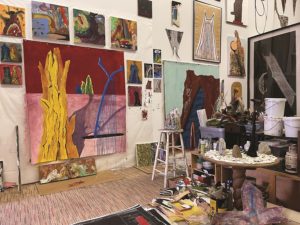
There’s plenty to see in Yarborough’s studio, not even counting the paintings that line the walls. There are tables covered with post cards, African sculptures, and other knick-knacks; shelves of art supplies; a wall of tools; a library filled with art books. A microwave sits on top of a retro-red refrigerator from which Yarborough grabs a seltzer as he heats some soup.
The middle section of the studio is where Yarborough gets messy with dyes, acrylics, and gouache. In the back of the studio, a lone window illuminates a drawing table. He also works on the floor, poring over sheafs of paper, architectural blueprints, and what he calls his “big-ass-atlas-sketchbook” that he paints, draws, and makes collages in.
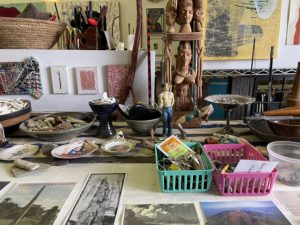
Yarborough’s studio routine has been set to the slow crawl of the pandemic. “I’m not rabidly working on any one thing,” he says. “I’m consistently working on many, many things.” He lives nearby, so he can stop in for an impromptu hour or two when he’s not there for a full day.
“After 45 years, I keep grinding away at it,” he continues. “Truly, I’m having a lot of fun. I come in here and I just move around like it’s a big sandbox! I’ve been lucky to do that.”



